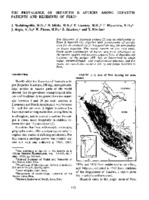The prevalence of hepatitis B antigen among hepatitis patients and residents of Peru
| dc.contributor.author | Madalengoitia, José | es_ES |
| dc.contributor.author | Ishida, N | es_ES |
| dc.contributor.author | Umenay, T | es_ES |
| dc.contributor.author | Miyamoto, T | es_ES |
| dc.contributor.author | Mejía, J | es_ES |
| dc.contributor.author | Flores, William | es_ES |
| dc.contributor.author | Sánchez, S | es_ES |
| dc.contributor.author | Méndez, R | es_ES |
| dc.date.accessioned | 2016 | |
| dc.date.available | 2016 | |
| dc.date.issued | 1975 | es_ES |
| dc.identifier.uri | https://iris.paho.org/handle/10665.2/27694 | |
| dc.description.abstract | Single radial immune diffusion and counterelectrophoresis tests were used to examine 2,593 serum speciments from apparently healthy men, women, and children of Peru for the presence of hepatitis B antigen (Australia antigen). The object was to estimate the prevalence of the antigen in two contrasting geographic regions and to investigate the relationship between presence of the antigen and jungle hepatitis in eastern Peru. In connection with the latter goal, both single and serial serum samples collected from hepatitis cases during an epidemic in the northeast were also examined. Of the 2,593 apparently healthy subjects, the tests showed 1.4 per cent were carrying the antigen. However, when the data were broken down by geographic region it was found that 1.8 per cent of the subjects from eastern Peru were carriers, as compared to only 0.5 per cent of those from the northern coast. Moreover, incidences as high as 5 and 6.4 per cent were found in selected eastern areas, and a peak figure of 14.3 per cent was found in sera from children living in some of these areas. Comparison of the proportions of male and female sera positive for the antigen indicated that the proportion of males with HB Ag was nearly twice as high. However, sera collected from Indians of 20 different eastern tribes and from mestizos in the eastern region showed roughly the same proportion of samples positive for HB Ag in each ethnic group. The study also showed a close correlation between presence of the antigen and hepatitis infection during a 1972-1973 epidemic in eastern Peru. Testing of sera taken from hepatitis patients at that time showed many patients to be carrying HB Ag, specially in cases where serial blood samples were available. In all, positive test results were obtained for 81.2 per cent of the patients from whom two or more samples had been obtained (Au) | en_US |
| dc.relation.ispartofseries | Bulletin of the Pan American Health Organization (PAHO);9(2),1975 | en_US |
| dc.subject | Hepatitis B | es_ES |
| dc.subject | Hepatitis B Antigens | es_ES |
| dc.subject | Peru | es_ES |
| dc.title | The prevalence of hepatitis B antigen among hepatitis patients and residents of Peru | en_US |
| dc.type | Journal articles | en_US |
| dc.rights.holder | Pan American Health Organization | en_US |
Files in this item
This item appears in the following Collection(s)
-
Pan American Journal of Public Health
Revista Panamericana de Salud Pública




